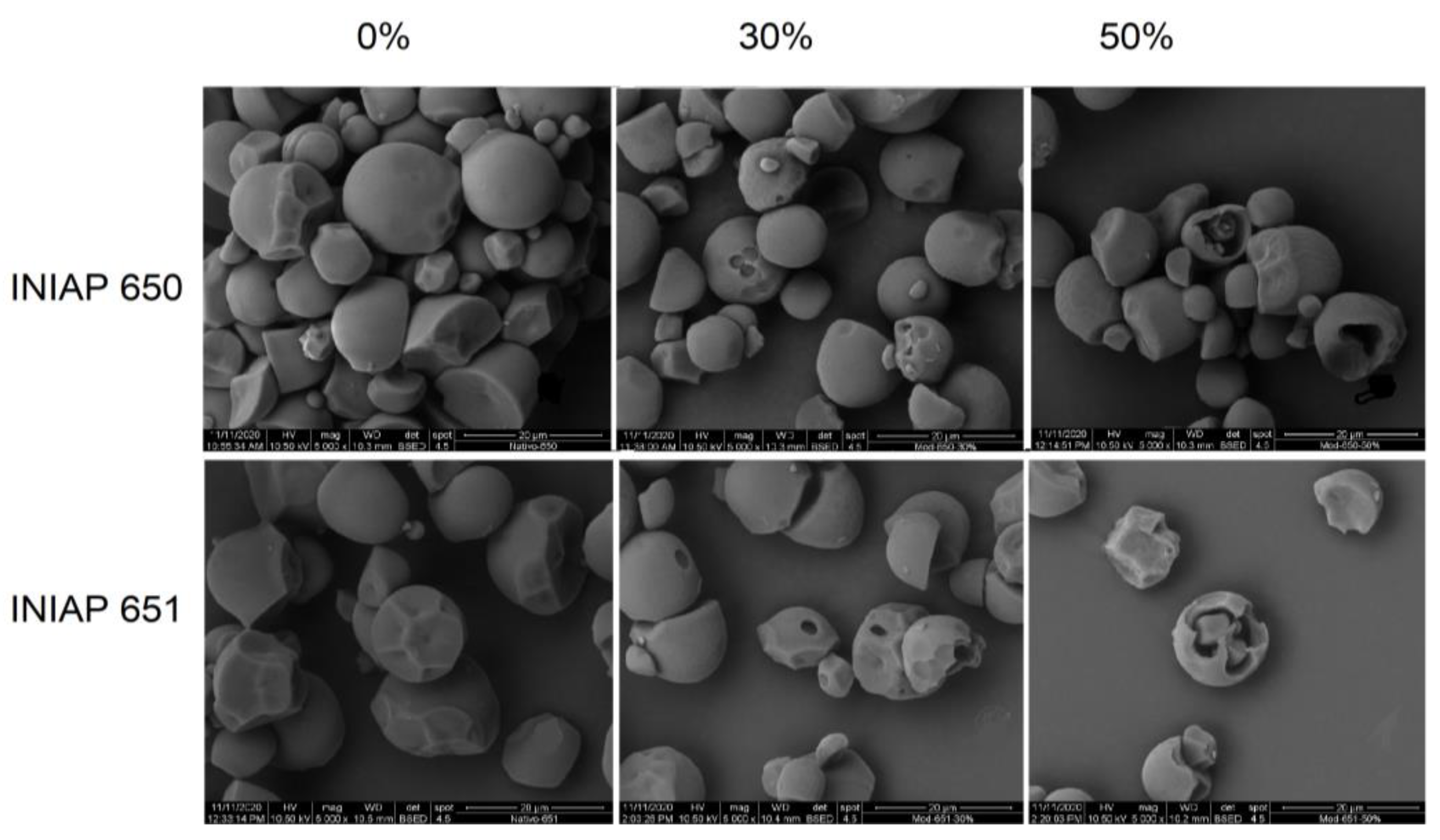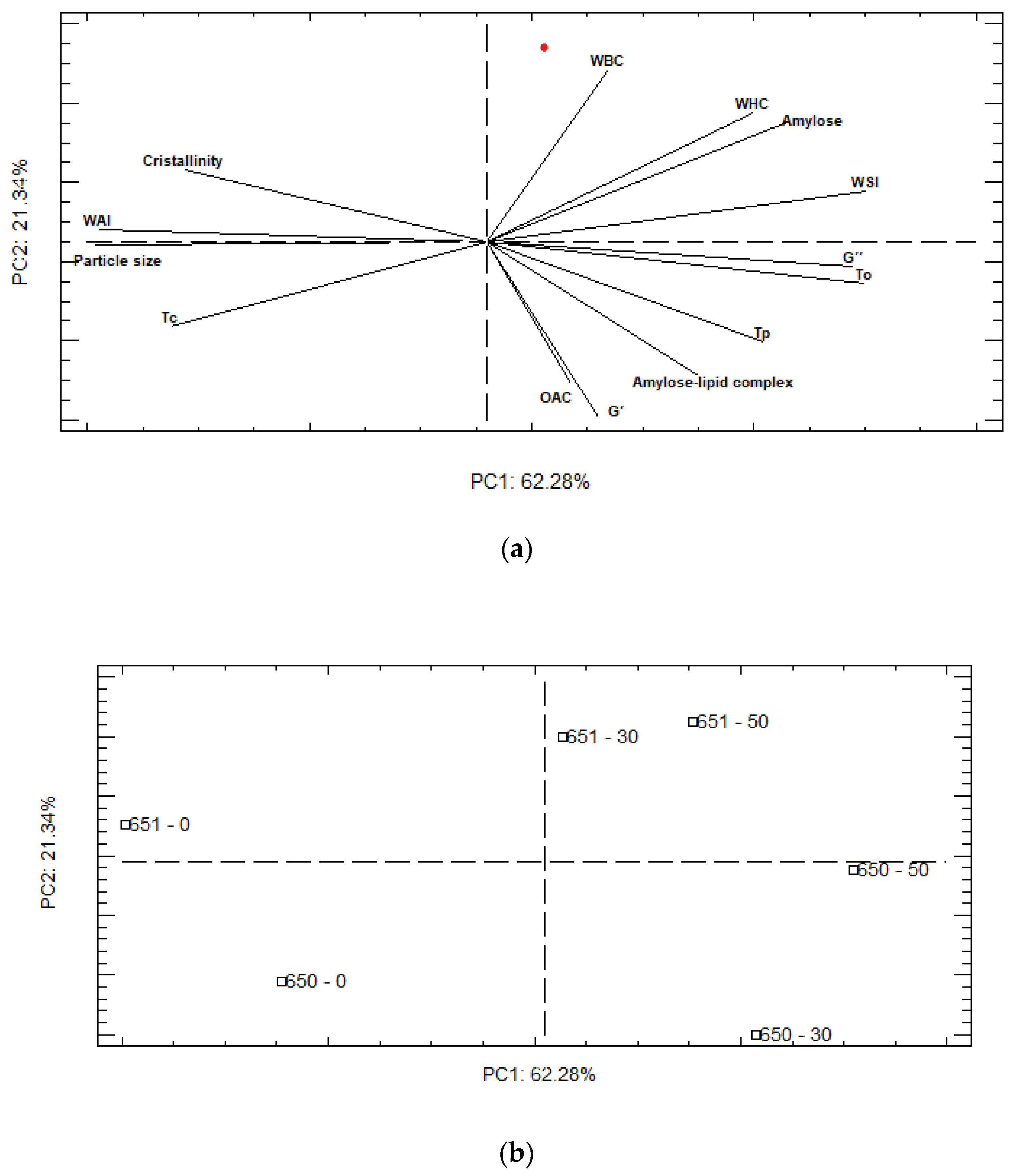Impact of Cassava Starch Varieties on the Physiochemical Change during Enzymatic Hydrolysis
Abstract
1. Introduction
2. Materials and Methods
2.1. Cassava Starch and Enzymes
2.2. Degree of Starch Hydrolysis
2.3. Structural Properties
2.4. Physicochemical Properties
2.5. Statistical Analysis
3. Results and Discussion
3.1. Structural Properties
3.2. Physicochemical Properties
3.3. Principal Component Analysis
4. Conclusions
Author Contributions
Funding
Institutional Review Board Statement
Informed Consent Statement
Data Availability Statement
Acknowledgments
Conflicts of Interest
References
- Benavent-Gil, Y.; Rosell, C.M. Comparison of porous starches obtained from different enzyme types and levels. Carbohydr. Polym. 2017, 157, 533–540. [Google Scholar] [CrossRef]
- Guo, L.; Yuan, Y.; Li, J.; Tan, C.; Janaswamy, S.; Lu, L.; Fang, Y.; Cui, B. Comparison of functional properties of porous starches produced with different enzyme combinations. Int. J. Biol. Macromol. 2021, 174, 110–119. [Google Scholar] [CrossRef]
- Han, X.; Wen, H.; Luo, Y.; Yang, J.; Xiao, W.; Ji, X.; Xie, J. Effects of α-amylase and glucoamylase on the characterization and function of maize porous starches. Food Hydrocoll. 2021, 116, 106661. [Google Scholar] [CrossRef]
- Benavent-Gil, Y.; Rosell, C.M. Morphological and physicochemical characterization of porous starches obtained from different botanical sources and amylolytic enzymes. Int. J. Biol. Macromol. 2017, 103, 587–595. [Google Scholar] [CrossRef] [PubMed]
- Chen, G.; Zhang, B. Hydrolysis of granular corn starch with controlled pore size. J. Cereal Sci. 2012, 56, 316–320. [Google Scholar] [CrossRef]
- Lacerda, L.D.; Leite, D.C.; Soares, R.M.D.; da Silveira, N.P. Effects of α-Amylase, Amyloglucosidase, and Their Mixture on Hierarchical Porosity of Rice Starch. Starch/Staerke 2018, 70, 1800008. [Google Scholar] [CrossRef]
- Benavent-Gil, Y.; Rosell, C.M. Performance of Granular Starch with Controlled Pore Size during Hydrolysis with Digestive Enzymes. Plant. Foods Hum. Nutr. 2017, 72, 353–359. [Google Scholar] [CrossRef] [PubMed]
- Dura, A.; Błaszczak, W.; Rosell, C.M. Functionality of porous starch obtained by amylase or amyloglucosidase treatments. Carbohydr. Polym. 2014, 101, 837–845. [Google Scholar] [CrossRef]
- Rasaq, S.A.; Shittu, T.A.; Fadimu, G.J.; Abass, A.B.; Omoniyi, O. Effect of cassava variety, fertiliser type and dosage on the physicochemical, functional and pasting properties of high-quality cassava flour (HQCF). Qual. Assur. Saf. Crops Foods 2020, 12, 18–27. [Google Scholar] [CrossRef]
- Tappiban, P.; Sraphet, S.; Srisawad, N.; Wu, P.; Han, H.; Smith, D.R.; Bao, J.; Triwitayakorn, K. Effects of cassava variety and growth location on starch fine structure and physicochemical properties. Food Hydrocoll. 2020, 108, 106074. [Google Scholar] [CrossRef]
- Silva, S. Carboxylation Study by Chemical Modification of Ecuadorian Cassava Starch. Undergraduate Thesis, Escuela Politécnica Nacional, Quito, Eduador, 2020. [Google Scholar]
- Jung, Y.S.; Lee, B.H.; Yoo, S.H. Physical structure and absorption properties of tailor-made porous starch granules produced by selected amylolytic enzymes. PLoS ONE 2017, 12, e0181372. [Google Scholar] [CrossRef] [PubMed]
- Hoover, R.; Ratnayake, W.S. Starch characteristics of black bean, chick pea, lentil, navy bean and pinto bean cultivars grown in Canada. Food Chem. 2002, 78, 489–498. [Google Scholar] [CrossRef]
- Tang, M.C.; Copeland, L. Analysis of complexes between lipids and wheat starch. Carbohydr. Polym. 2007, 67, 80–85. [Google Scholar] [CrossRef]
- Cornejo, F.; Rosell, C.M. Physicochemical properties of long rice grain varieties in relation to gluten free bread quality. LWT-Food Sci. Technol. 2015, 62, 1203–1210. [Google Scholar] [CrossRef]
- Keeratiburana, T.; Hansen, A.R.; Soontaranon, S.; Blennow, A.; Tongta, S. Porous high amylose rice starch modified by amyloglucosidase and maltogenic α-amylase. Carbohydr. Polym. 2020, 230, 115611. [Google Scholar] [CrossRef] [PubMed]
- Zhao, A.Q.; Yu, L.; Yang, M.; Wang, C.J.; Wang, M.M.; Bai, X. Effects of the combination of freeze-thawing and enzymatic hydrolysis on the microstructure and physicochemical properties of porous corn starch. Food Hydrocoll. 2018, 83, 465–472. [Google Scholar] [CrossRef]
- Uthumporn, U.; Zaidul, I.S.M.; Karim, A.A. Hydrolysis of granular starch at sub-gelatinization temperature using a mixture of amylolytic enzymes. Food Bioprod. Process. 2010, 88, 47–54. [Google Scholar] [CrossRef]
- Prompiputtanapon, K.; Sorndech, W.; Tongta, S. Surface Modification of Tapioca Starch by Using the Chemical and Enzymatic Method. Starch/Staerke 2020, 72, 1900133. [Google Scholar] [CrossRef]
- Yang, Z.; Xu, X.; Singh, R.; de Campo, L.; Gilbert, E.P.; Wu, Z.; Hemar, Y. Effect of amyloglucosidase hydrolysis on the multi-scale supramolecular structure of corn starch. Carbohydr. Polym. 2019, 212, 40–50. [Google Scholar] [CrossRef]
- Chen, Y.; Dai, G.; Gao, Q. Preparation and properties of granular cold-water-soluble porous starch. Int. J. Biol. Macromol. 2020, 144, 656–662. [Google Scholar] [CrossRef] [PubMed]
- Wasserman, L.A.; Papakhin, A.A.; Borodina, Z.M.; Krivandin, A.V.; Sergeev, A.I.; Tarasov, V.F. Some physico-chemical and thermodynamic characteristics of maize starches hydrolyzed by glucoamylase. Carbohydr. Polym. 2019, 212, 260–269. [Google Scholar] [CrossRef]
- Li, C.; Gong, B. Insights into chain-length distributions of amylopectin and amylose molecules on the gelatinization property of rice starches. Int. J. Biol. Macromol. 2020, 155, 721–729. [Google Scholar] [CrossRef]
- Jane, J.L.; Chen, Y.Y.; Lee, L.F.; McPherson, A.E.; Wong, K.S.; Radosavljevic, M.; Kasemsuwan, T. Effects of amylopectin branch chain length and amylose content on the gelatinization and pasting properties of starch. Cereal Chem. 1999, 76, 629–637. [Google Scholar] [CrossRef]
- Chen, Y.; Huang, S.; Tang, Z.; Chen, X.; Zhang, Z. Structural changes of cassava starch granules hydrolyzed by a mixture of α-amylase and glucoamylase. Carbohydr. Polym. 2011, 85, 272–275. [Google Scholar] [CrossRef]
- Wang, S.; Chao, C.; Cai, J.; Niu, B.; Copeland, L.; Wang, S. Starch–lipid and starch–lipid–protein complexes: A comprehensive review. Compr. Rev. Food Sci. Food Saf. 2020, 19, 1056–1079. [Google Scholar] [CrossRef] [PubMed]




| Variety | INIAP 650 | INIAP 651 | p Value * | |||||
|---|---|---|---|---|---|---|---|---|
| % Hydrolysis Degree | 0% | 30% | 50% | 0% | 30% | 50% | Variety | Hydrolysis |
| Crystallinity (%) | 25.70 ± 1.90 b,c | 21.50 ± 1.03 a,b | 18.98 ± 0.39 a | 27.06± 2.64 c | 23.72 ± 3.39 a,b,c | 28.22 ± 1.57 c | 0.022 | 0.025 |
| Particle < size D (4, 3) (µm) | 6.65 ± 1.44 b,c | 5.83 ± 1.38 a,b | 5.81 ± 1.03 a,b | 7.06 ± 1.70 c | 6.05 ± 1.19 a,b | 5.96 ± 1.12 a,b | 0.096 | 0.014 |
| Amylose (g/100 g) | 23.68 ± 0.33 a | 26.24 ± 0.51 b | 28.57 ± 0.77 c | 24.46 ± 0.19 a | 28.24 ± 0.38 c | 30.46 ± 0.19 d | <0.001 | <0.001 |
| Amylose–lipid complex | 26.52 ± 1.09 c | 26.45 ± 1.11 c | 27.54 ± 0.83 c | 7.34 ± 0.82 a | 14.96 ± 0.62 b | 14.19 ± 1.60 b | <0.001 | 0.001 |
| WBC (g/g) | 1.01 ± 0.07 a | 0.99 ± 0.07 a | 1.16 ± 0.04 b,c | 1.09± 0.04 a,b | 1.18 ± 0.01 c | 1.20 ± 0.08 c | 0.010 | 0.008 |
| WHC (g/g) | 0.86 ± 0.03 a | 0.87 ± 0.01 a | 1.00 ± 0.06 b,c | 0.87 ± 0.03 a | 0.95 ± 0.07 b | 1.02 ± 0.05 b,c | 0.081 | <0.001 |
| WAI (g/g) | 12.37 ± 0.12 c | 6.22 ± 0.29 a | 6.78 ± 0.34 a | 12.91 ± 0.43 d | 8.47 ± 0.15 b | 8.57 ± 0.24 b | <0.001 | <0.001 |
| WSI (g/100 g) | 0.05 ± 0.00 a | 3.52 ± 0.64 b | 4.53 ± 0.23 c | 0.05 ± 0.01 a | 3.80 ± 0.20 b | 3.73 ± 0.31 b | 0.329 | <0.001 |
| OAC (g/g) | 1.99 ± 0.06 b | 2.88 ± 0.01 c | 1.89 ± 0.07 a | 2.05 ± 0.10 b | 1.81 ± 0.04 a | 1.80 ± 0.01 a | 0.031 | 0.434 |
| To (°C) | 65.04 ± 0.35 b | 66.96 ± 0.15 c | 67.81 ± 0.09 d | 62.99 ± 0.30 a | 65.31 ± 0.07 b | 66.42 ± 0.03 c | <0.001 | <0.001 |
| Tp (°C) | 69.40 ± 0.14 d | 69.51 ± 0.15 d | 69.86 ± 0.10 d | 67.29 ± 0.27 a | 67.79 ± 0.26 b | 68.90 ± 0.02 c | <0.001 | <0.001 |
| Tc (°C) | 81.28 ± 0.82 d | 74.01 ± 0.59 a,b | 74.07 ± 0.09 a,b | 79.57 ± 1.80 c | 72.33 ± 0.48 a | 73.01 ± 0.06 a | 0.002 | <0.001 |
| ∆H (J/g) | 3.28 ± 0.30 b | 1.74 ± 0.07 a | 1.66 ± 0.08 a | 3.32 ± 0.26 b | 1.60 ± 0.14 a | 1.38 ± 0.12 a | 0.142 | <0.001 |
| Ig (°C) | 16.20 ± 0.52 b | 7.04 ± 0.74 a | 6.26 ± 0.00 a | 16.59 ± 1.92 b | 7.02 ± 0.55 a | 6.59 ± 0.09 a | 0.636 | <0.001 |
| G′ (Pa) | 85.28 ± 2.81 a | 95.83 ± 3.33 a | 85.18 ± 32.27 a | 72.28 ± 20.15 a | 70.48 ±16.23 a | 65.76 ± 2.05 a | 0.253 | 0.289 |
| G″ (Pa) | 2804.50 ± 153.44 a | 3706.00 ± 171.12 b | 3441.00 ± 381.84 b | 2832.00 ± 275.70 a | 3278.50 ± 7.79 a,b | 3312.50 ± 74.25 a,b | 0.235 | 0.005 |
Publisher’s Note: MDPI stays neutral with regard to jurisdictional claims in published maps and institutional affiliations. |
© 2022 by the authors. Licensee MDPI, Basel, Switzerland. This article is an open access article distributed under the terms and conditions of the Creative Commons Attribution (CC BY) license (https://creativecommons.org/licenses/by/4.0/).
Share and Cite
Cornejo, F.; Maldonado-Alvarado, P.; Palacios-Ponce, S.; Hugo, D.; Rosell, C.M. Impact of Cassava Starch Varieties on the Physiochemical Change during Enzymatic Hydrolysis. Molecules 2022, 27, 6098. https://doi.org/10.3390/molecules27186098
Cornejo F, Maldonado-Alvarado P, Palacios-Ponce S, Hugo D, Rosell CM. Impact of Cassava Starch Varieties on the Physiochemical Change during Enzymatic Hydrolysis. Molecules. 2022; 27(18):6098. https://doi.org/10.3390/molecules27186098
Chicago/Turabian StyleCornejo, Fabiola, Pedro Maldonado-Alvarado, Sócrates Palacios-Ponce, David Hugo, and Cristina M. Rosell. 2022. "Impact of Cassava Starch Varieties on the Physiochemical Change during Enzymatic Hydrolysis" Molecules 27, no. 18: 6098. https://doi.org/10.3390/molecules27186098
APA StyleCornejo, F., Maldonado-Alvarado, P., Palacios-Ponce, S., Hugo, D., & Rosell, C. M. (2022). Impact of Cassava Starch Varieties on the Physiochemical Change during Enzymatic Hydrolysis. Molecules, 27(18), 6098. https://doi.org/10.3390/molecules27186098






